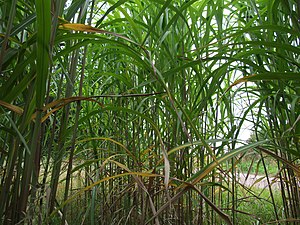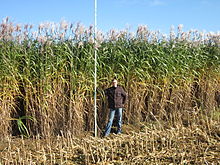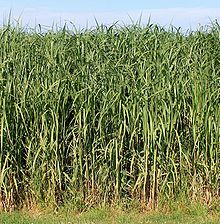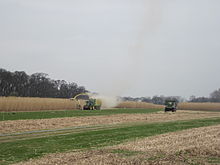Giant Chinese reeds
| Giant Chinese reeds | ||||||||||||
|---|---|---|---|---|---|---|---|---|---|---|---|---|

Giant Chinese reed ( Miscanthus × giganteus ) |
||||||||||||
| Systematics | ||||||||||||
|
||||||||||||
| Scientific name | ||||||||||||
| Miscanthus × giganteus | ||||||||||||
| JM Greef & Deuter ex Hodk. & Renvoize |
Giant Chinese reed ( Miscanthus × giganteus ) is a natural cross between the Chinese reed ( Miscanthus sinensis ) and Miscanthus sacchariflorus . It is originally from Japan . Around 1935 Miscanthus × giganteus was introduced to Central Europe via Denmark .
Giant Chinese reed has what is known as C4 metabolism , a form of photosynthesis that is particularly productive under certain environmental conditions ; Therefore, compared to the C3 plants , the plant is characterized by a particularly high biomass output under certain climatic conditions . It can also reach heights of up to four meters in Europe and is therefore increasingly grown as a renewable raw material for energetic and material use.
A 2015 review study found that giant Chinese reed is one of the three most productive energy crops. Higher yields were only achieved with pile reed ( Arundo donax ) and napier grass ( Pennisetum purpureum ), although their higher yields were only achieved in a limited number of locations and therefore have to be confirmed by further studies.
features
The giant Chinese silver grass is a triploid hybrid with 57 chromosomes , which was created by hybridizing a tetraploid form of Miscanthus sacchariflorus with 76 and a diploid form of the Chinese silver grass ( Miscanthus sinensis ) with 36 chromosomes. The plant accordingly combines features of both types of origin.
Like all Miscanthus species, it is perennial and forms a sprout-borne rhizome from which the plants sprout . The shoot reaches a height of three to four meters with lance-shaped, partly erectophilic leaf blades , which means that optimal use of light is achieved. Like other C4 plants, such as maize and sugar cane , Miscanthus is characterized by its very productive photosynthesis , which leads to a high level of biomass production . In doing so, around 2.5 grams of biomass are formed per megajoule of absorbed radiation.
Distribution and habitat
Giant Chinese reed can be found as a natural hybrid in Japan, although the exact place of origin for the cross is not known. It is assumed that it originated in a subtropical region of central Japan.
The variety, which is grown as a renewable raw material, can also bloom in Central Europe in warm summers, but cannot develop any viable seeds . An uncontrolled spread via rhizome or root pieces is considered unlikely, since Miscanthus, as a C4 plant, only grows very slowly in spring and is therefore very weak in competition with domestic plants.
In Central Europe, giant Chinese reeds are used as "wintering quarters" by a large number of small organisms such as spiders and beetles . Deer and wild boars use the miscanthus populations as refuge in the agricultural landscapes that have been tidied up over the winter .
Taxonomy
Miscanthus × giganteus J.M. Greef & Deuter ex Hodk. & Renvoize is the result of the cross of Miscanthus sacchariflorus × Miscanthus sinensis . Its current name is Miscanthus × longiberbis (Hack.) Nakai . Synonyms are: Miscanthus matsumurae var. Longiberbis Hack. , Miscanthus hackelii var. Breviberbis Honda and Miscanthus × ogiformis Honda .
use
Usage history
Known in the areas of origin as a raw material for mats and wickerwork for privacy and wind protection as well as a fodder plant and for a long time only used as an ornamental plant in gardens in Central Europe , giant Chinese reed moved into the focus of research and research in the late 1970s in the search for alternative energy sources Development. The plant was not only examined as a possible source of biomass, but also as a fiber plant. Because of the possible high dry matter yield (15 to 25 tons per hectare according to tests by the Baden-Württemberg Ministry of Agriculture), it played a certain role as a renewable raw material from now on.
High hopes were placed on the plant in the late 1980s. Between 1991 and 1994 the German federal government and Veba Öl AG provided intensive research funding for the provision of biomass and for the energetic and material use of Miscanthus × giganteus . At that time, the raw material plant could not meet the high expectations placed on it. High winter losses in the year of planting, high planting material costs, storage problems due to the low bulk density, the lack of possible uses for the raw material obtained and a lack of economic viability were the main problems of large-scale cultivation after the end of the project.
Some of the originally existing problems have now been solved through research funding and a pioneering spirit within agriculture. Through the development of rhizome reproduction, the problem of winter losses could be reduced and the costs of planting material reduced to less than half. Meanwhile, a variety of different forms of use of giant miscanthus have established that the material use in lightweight concrete blocks , about animal bedding , through to energy use in biomass combustion plants rich. Due to the sharp rise in heating oil prices (by more than a factor of 5 since 1994), the economic viability is now also much more positive with regard to other conversion processes (e.g. liquefaction, pyrolysis).
ingredients
| calorific value | 18.1-18.5 MJ / kg |
|---|---|
| Ash content | 2.7-3.1% |
| chlorine | 0.2% |
| nitrogen | 0.4% |
| potassium | 0.5% |
| sulfur | 0.06% |
| lignin | 21-24% |
| Holocellulose | 75-81 wt% ba tm |
The ingredient concentrations of the above-ground biomass vary greatly depending on the time of harvest, the weather during the winter months and the properties of the soil. In general, the later the harvest time is chosen, the lower the mineral content . This is particularly true for chlorine, potassium and sulfur. This can be explained on the one hand by the nutrient storage process and on the other hand by the flushing out of the nutrients by rainwater. For the production of biomass for energy recovery, use should also be made of locations that were not previously fertilized with fertilizers containing chlorine. The table on the right gives guidelines for quality-determining biomass parameters and ingredient concentrations of the Miscanthus × giganteus variety .
Energetic use
In the meantime, the fast-growing Chinese reed is used to a certain extent as a fuel for generating energy in biomass thermal power stations because of its high calorific value and its favorable carbon dioxide balance . Pilot projects exist in Austria and Germany . In Austria, subsidies for cultivation are possible through the detour of the closure premium from the Chamber of Agriculture .
A major advantage of giant Chinese reeds is the relatively high dry matter yield per hectare in connection with a very low water requirement. The relocation of the nutrients from the leaves to the rhizome towards the end of the growing season is also advantageous . This reduces the need for fertilization of this plant compared to other crops. Due to the multi-year harvest without annual sowing, the annual energy-intensive soil preparation work is also eliminated, which significantly improves the energy balance compared to other renewable raw materials, such as rapeseed as a vegetable fuel .
Disadvantages for the producer are the limited cultivation experience, the high investments for the seedlings and the permanent area binding in the case of perennial crops, which prevent a quick reaction to changes in EU agricultural policy.
Due to the relatively low bulk density , apart from the cultivation problems mentioned above, transport over long distances is unprofitable. When used in close proximity to promote regional energy independence, however, this fact is no longer to be regarded as a disadvantage because of the short distances. Pelleting the raw material can also help; however, the first pelleting attempts are still in the early stages. Briquetting, on the other hand, has already been tried and tested : with hydraulic briquetting presses , briquettes with a diameter of 5 to approx. 7 cm can be produced much more cost-effectively than pellets with a pelleting machine .
The formation of slag during the combustion of the chopped material is still problematic , which - like straw - has a high silicon content and therefore cannot be burned in all wood chip firing systems. Due to the growing interest, not least because of the rising crude oil prices , an increased development on the part of the boiler manufacturers can be observed.
Material use
The giant Chinese reed can also be used in numerous ways when it comes to material use. As an aggregate for lightweight concrete blocks, it offers the advantage of improving the insulating properties of the concrete body. In Germany it has so far only been used as a filler material for chipboard , the cultivation area for this use corresponds to a maximum of 50 ha (Heyer 2008) and thus a total mass of a maximum of 1,500 t dry matter. In addition, it could be important in the future together with short rotation wood as a lignocellulose-rich raw material for the supply of biorefinery technology.
Cultivation
Breeding, varieties
So far, a high biomass output and sufficient winter hardiness have been the most important criteria for choosing a variety. Cultivation experience from large-scale cultivation is available for Miscanthus × giganteus and the earlier ripening multi-clone variety 'Amuri'. Miscanthus × giganteus is by far the most widely grown variety. In the nineties, cultivation trials were also carried out with the Miscanthus sinensis varieties 'Goliath', 'Poseidon' and others, which, however, were not successful due to the low yields. Increasingly, different cultivars and genotypes are also being examined for their suitability for various specific uses. Plants with particularly good binding properties have already been found for use as an aggregate for lightweight concrete blocks. The long-term goal is the selection of high-yielding varieties that are particularly suitable for incineration, pyrolysis or liquefaction due to their positive chemical-physical properties .
Location requirements
As a rule of thumb for the siting of the comparison is to maize drawn cultivation. A good corn site is also a good miscanthus site. So deep, well-rooted, humus clay soils with good water flow, good nutrient storage capacity and rainfall between 500 and 600 mm during the growing season are ideal . Light, sandy to loamy sand soils are also suitable for cultivation. Insufficient water supply between June and September (the main growing season) can become a limiting factor here. A total failure is almost impossible due to the underground storage system. Miscanthus can be grown on a very wide range of soils and is first “tried” in many farms at border locations. The success is often surprisingly positive. As with maize cultivation, altitudes over 700 meters above sea level are rather unsuitable.
As a heat- loving C4 plant, it needs locations with an average temperature of at least 8 ° C. Late frosts can damage young shoots.
Locations with deep, humus-rich and sandy-loamy soils with a good soil structure and water supply as well as a high nutrient storage capacity are particularly suitable for the cultivation of miscanthus. Cold soils that tend to become waterlogged and lack aeration are not suitable. On very sandy soils with a low groundwater level , the amount of precipitation and the seasonal distribution of precipitation determine the yield level.
Tillage and planting
Due to its peculiarity as a triploid hybrid bastard , the plant lacks the ability to develop germinable seeds. It forms underground storage organs - rhizomes - for overwintering and reproduction. Miscanthus x giganteus is clump-forming, so that there is no uncontrolled overgrowth. The eyrie extends over an area of approx. 1 m², hence the rule of thumb of one rhizome per square meter . Miscanthus is a shallow root and therefore no danger on drained areas. Due to the properties mentioned above, propagation is therefore only possible vegetatively by dividing the rhizomes or via micro- propagation processes . In practice, rhizome planting has prevailed against meristem propagation (early young plants). Establishing a stand with rhizomes is easier, cheaper and the rate of growth is comparable. To be on the safe side and because the row spacing of the planting technique (75 cm), which often exists, 1.3 rhizomes per square meter are often planted. It is planted with converted potato planters or specially constructed planting machines . The planting date is between the end of March and mid- May . In the case of early plants, they should only be planted after the late frosts have ended. The planting process itself can be done with the simplest means when establishing a stand. More important are field preparation, rhizome quality, reconsolidation and subsequent maintenance. To prepare the field, creating a plow furrow and then fine loosening it with the power harrow is usually the best solution. The soil is then well loosened and the field is initially "free" of weeds . The subsequent reconsolidation is then carried out either by the planting machine (a wheel runs on the row of plants) or by repeated processing with the rotary harrow, which then runs very flat and almost exclusively on the roller. At high N-replenishment , so grassland upheaval or incorporation of large amounts of organic matter , it may be a nitrogen supply. This leads to a delay in ripening and thus to less nutrient storage in the rhizome. This can be problematic in terms of frost resistance and regrowth. Individual cases of wireworm infestation are also known from grassland and set-aside plowing , but this problem is often associated with inferior planting material. This brings up a crucial topic - the rhizome quality. On the one hand, the nature of the rhizome is important. The piece of rhizome should be sufficiently large (6-13 cm long) and have sufficiently well-developed "eyes" (3 - 5 slightly reddish buds). On the other hand, the rhizomes tend to dry out quickly and should therefore be replanted as soon as possible after clearing . During this time they must be kept moist and stored away from the wind. Care should also be taken that the mother population is not too old, as otherwise the death rate increases enormously. Professional multipliers create test or reference stocks annually to ensure good rhizome quality. Planting material prices vary greatly with the purchase quantity and should be requested directly from the supplier in connection with availability.
Plant protection
Giant Chinese reed needs weed control, especially in the first but often also in the second year of standing, because the plant is extremely weak in competition before it closes. From the third year of standing, the stands are dense and closed, so weeds are completely suppressed. There are individual herbicides that have a permit under Article 51 of the Licensing Ordinance for use in Miscanthus. Additional resources must be "activated" by the user with individual approval. This exemption according to § 22 , para. 2 (formerly § 18b) of the Plant Protection Act (PflSchG) can be obtained relatively unproblematic, since the service to residue freedom for food and feed at NaWaRo disappears practically ease of use. It is up to the user to see whether the product ultimately works in the miscanthus. For mechanical weed control, we recommend the use of a weed harrow or, against problematic weeds, the use of standard corn row cultivators. During the initial phase, if there is strong weed pressure in the row, manual hoeing must be carried out.
harvest
Giant Chinese reed shifts a large part of the nutrients present in the shoot into the underground storage organ (rhizome) over the winter months . This relocation process is accompanied by a decrease in the moisture content of the above-ground shoot mass. There are two reasons why you should only harvest in the period from January to March:
- the nutrients shifted into the rhizome are available to the plant in spring for a vigorous re-growth.
- the above-ground sprout to be harvested has already dried to around 18–20% moisture content and can usually be used for energy purposes (e.g. by incineration) without technical subsequent drying.
The harvest should be done as late as possible in spring, i.e. just before the new shoots in April. At a later point in time, not only are the dry matter contents higher, but also - especially important for energetic use - the chlorine contents are lower. It should also be ensured that most of the leaves have already fallen off. The nutrient-rich leaves, which decompose on the ground, give the minerals back to the vegetation and thus help to close the nutrient cycle. A high ash- rich leaf content can also lead to technical malfunctions in biomass combustion systems. Depending on the subsequent utilization purpose, harvesting can be carried out with a forage harvester with a row-independent cutting unit (chopping chain) or with a mower-articulated tedder (bale line). For the bale line, the crop is then placed on a swath and pressed into bales . There are already combinations in which the crop is transferred directly from the chopper to a baler . This offers the advantage that the harvested crop does not come into contact with the ground and therefore contains fewer foreign substances ( earth , sand , wet leaves, etc.) and therefore has better combustion properties. Depending on the site conditions, yields of 10–20 t dry matter / ha * year are possible. With an optimal water supply , for example through irrigation , much higher yields can be expected, which can reach up to 25–30 t dry matter / ha.
Individual evidence
- ^ A. Laurent, E. Pelzer, C. Loyce, D. Makowski, Ranking yields of energy crops: A meta-analysis using direct and indirect comparisons . In: Renewable and Sustainable Energy Reviews 46, (2015), 41–50, S- 47f, doi: 10.1016 / j.rser.2015.02.023 .
- ^ Pude 2006
- ↑ Rafaël Govaerts (Ed.): Miscanthus. In: World Checklist of Selected Plant Families (WCSP) - The Board of Trustees of the Royal Botanic Gardens, Kew . Accessed May 31, 2020.
- ↑ a b Production aspects of willow and miscanthus (PDF file; 347 kB)
- ↑ Planet Knowledge: Materials made from plants
- ↑ a b c d e f Hartmann, H., 2007: Standardization of mixed fuels for KFA and need for action, Technologie- und Förderzentrum (TFZ) Straubing, technical discussion "Mixed pellets and alternative fuels for KFA potential and need for action", specialist event of the FNR on 1 March 2007
- ↑ a b Symposium Miscanthus; Biomass provision, energetic and material use, series "Renewable raw materials" FNR, Volume 4, 1995
- ↑ Lewandowski, I., 1996: Influence of plant production on the fuel properties using the example of grasses . In: "Properties of solid bioenergy carriers" - International conference in Stuttgart in May 1996. Series of publications "Renewable Raw Materials" (6), Agency for Renewable Raw Materials (Ed.): Landwirtschaftsverlag Münster, pp. 32–48.
- ↑ Miscanthus.at by Hubert Falzberger ( Memento of the original from June 24, 2008 in the Internet Archive ) Info: The archive link was inserted automatically and has not yet been checked. Please check the original and archive link according to the instructions and then remove this notice.
- ↑ a b c KTBL: Energy Plants. KTBL data collection, 2006, pp. 151–163.
- ↑ PUDE, R., 2005: Significance of morphological, chemical and physical parameters and their interactions for assessing the suitability of building materials of different Miscanthus origins. Contributions to Agricultural Sciences Vol. 30. Verl. Wehle, Bad Neuenahr
- ↑ a b http://www.sieverdingbeck-agrar.de/ Sieverdingbeck Agrar: Miscanthus cultivation and advice
- ^ Miscanthus Sieverdingbeck: Miscanthus plant protection
- ^ Miscanthus Sieverdingbeck: Miscanthus harvest
- ↑ http://www.miscanthus.lu:/ Miscanthus-Hächsel as horse litter
literature
- Werner Kuhn, Steffen Jodl: From ornamental grass to raw material plants: 10 years of miscanthus research. Bavarian State Institute for Viticulture and Horticulture (LWG)
- D. Wolters: Bioenergy from organic farming: possibilities and potentials. Wuppertal Paper No. 91, 1999
- Christine Rösch: Sustainable use of biomass as an energy source. Institute for Technology Assessment and Systems Analysis (ITAS), Research Center Karlsruhe, TA Database News, No. 3, Volume 10, Sept. 2001, pp. 27–34.
- Wolfgang Ständer: Energy problems solved in the future. Brochure of the Society for Health Advice GGB eV, 1990
- Board of Trustees for Technology and Construction in Agriculture (KTBL): Energy Plants. KTBL-Datenammlung., 2006, pp. 151-163.
- Ralf Pude: Importance of morphological, chemical and physical parameters as well as their interactions for assessing the suitability of building materials from different Miscanthus origins. Contributions to Agricultural Sciences Vol. 30. Publ. Wehle, Bad Neuenahr 2005.
- Ralf Pude: Chinese reed, miscanthus. In: Klaus-Ulrich Heyland, Herbert Hanus, Ernst Robert Keller: Oil fruits, fiber plants, medicinal plants and special crops. Handbook of Plant Cultivation Volume 4, Eugen Ulmer KG, Stuttgart 2006, ISBN 3-8001-3203-6 , pp. 582-587.
- I. Lewandowski: Possibilities of influencing plant production on fuel properties using the example of grasses. In: "Properties of solid bioenergy carriers" - International conference in Stuttgart in May 1996. Series of publications Renewable Raw Materials (6), Agency for Renewable Raw Materials (Ed.): Landwirtschaftsverlag Münster, pp. 32–48.
- S. Kiesewalter, C. Röhricht: Experiences from combustion studies on the use of mixed fuels, technical discussion "Mixed pellets and alternative fuels for KFA - potentials and need for action". FNR specialist event on March 1, 2007
- Miscanthus Symposium; Biomass provision, energetic and material use. Publication series "Renewable Raw Materials" FNR, Volume 4, 1995
Web links
- Thomas Meyer: Data sheet with identification key and photos at Flora-de: Flora von Deutschland (old name of the website: Flowers in Swabia )
- www.miscanthus.de - Information from the teaching and research station of the University of Bonn on Miscanthus sinensis
- Biomass - what is it? Planet-Wissen WDR / SWR / BR-alpha, 2006
- Biomass as an energy source . In: Factor four. Wuppertal Institute for Climate, Environment and Energy GmbH
- Miscanthus as fuel - eco-heat Falzberger KEG: planting, plant protection
- Michael Pankratius Lexicon Renewable Resources
- http://www.sieverdingbeck-agrar.de/
- http://miscanthus-ascheberg.de/





